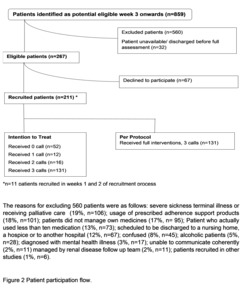Odeh, M;
Scullin, C;
Fleming, G;
Scott, MG;
Horne, R;
McElnay, JC;
(2019)
Ensuring continuity of patient care across the healthcare interface: Telephone follow-up post-hospitalization.
British Journal of Clinical Pharmacology
, 85
(3)
pp. 616-625.
10.1111/bcp.13839.

![[thumbnail of Mohanad Figure 1 Study methodology summary.png]](https://discovery.ucl.ac.uk/10076775/5.hassmallThumbnailVersion/Mohanad%20Figure%201%20Study%20methodology%20summary.png)  Preview |
Image
Mohanad Figure 1 Study methodology summary.png - Accepted Version Download (450kB) | Preview |
![[thumbnail of Mohanad Figure 2 Patient participation flow.png]](https://discovery.ucl.ac.uk/10076775/10.hassmallThumbnailVersion/Mohanad%20Figure%202%20Patient%20participation%20flow.png)  Preview |
Image
Mohanad Figure 2 Patient participation flow.png - Accepted Version Download (392kB) | Preview |
![[thumbnail of Figure 3 Kaplan-Meier curves of time to readmission_.png]](https://discovery.ucl.ac.uk/10076775/15.hassmallThumbnailVersion/Figure%203%20Kaplan-Meier%20curves%20of%20time%20to%20readmission_.png)  Preview |
Image
Figure 3 Kaplan-Meier curves of time to readmission_.png - Accepted Version Download (1MB) | Preview |
Preview |
Text
Horne Mohanad BJCP final approved.pdf - Accepted Version Download (345kB) | Preview |
Preview |
Text
Horne Mohanad BJCP tables 16 oct.pdf - Accepted Version Download (634kB) | Preview |
Abstract
Aims To implement pharmacist‐led, postdischarge telephone follow‐up (TFU) intervention and to evaluate its impact on rehospitalization parameters in polypharmacy patients, via comparison with a well‐matched control group. Method Pragmatic, prospective, quasi‐experimental study. Intervention patients were matched by propensity score techniques with a control group. Guided by results from a pilot study, clinical pharmacists implemented TFU intervention, added to routine integrated medicines management service. Results Using an intention to treat approach, reductions in 30‐ and 90‐day readmission rates for intervention patients compared with controls were 9.9% [odds ratio = 0.57; 95% confidence interval (CI): 0.36–0.90; P < 0.001] and 15.2% (odds ratio = 0.53; 95% CI: 0.36–0.79; P = 0.021) respectively. Marginal mean time to readmission was 70.9 days (95% CI: 66.9–74.9) for intervention group compared with 60.1 days (95% CI: 55.4–64.7) for controls. Mean length of hospital stay compared with control was (8.3 days vs. 6.7 days; P < 0.001). Benefit: cost ratio for 30‐day readmissions was 29.62, and 23.58 for 90‐day interval. Per protocol analyses gave more marked improvements. In intervention patients, mean concern scale score, using Beliefs about Medicine Questionnaire, was reduced 3.2 (95% CI: –4.22 to −2.27; P < 0.001). Mean difference in Medication Adherence Report Scale was 1.4 (22.7 vs. 24.1; P < 0.001). Most patients (83.8%) reported having better control of their medicines after the intervention. Conclusions Pharmacist‐led postdischarge structured TFU intervention can reduce 30‐ and 90‐day readmission rates. Positive impacts were noted on time to readmission, length of hospital stay upon readmission, healthcare costs, patient beliefs about medicines, patient self‐reported adherence and satisfaction.
| Type: | Article |
|---|---|
| Title: | Ensuring continuity of patient care across the healthcare interface: Telephone follow-up post-hospitalization |
| Open access status: | An open access version is available from UCL Discovery |
| DOI: | 10.1111/bcp.13839 |
| Publisher version: | https://doi.org/10.1111/bcp.13839 |
| Language: | English |
| Additional information: | This version is the author accepted manuscript. For information on re-use, please refer to the publisher’s terms and conditions. |
| Keywords: | Science & Technology, Life Sciences & Biomedicine, Pharmacology & Pharmacy, clinical pharmacists, postdischarge follow-up, readmission rate, rehospitalization, INTEGRATED MEDICINES MANAGEMENT, COST-BENEFIT-ANALYSIS, PROPENSITY SCORE, RE-AIM, SERVICE, INTERVENTION, ADHERENCE, READMISSIONS, IMPROVEMENT, PROGRAM |
| UCL classification: | UCL UCL > Provost and Vice Provost Offices > School of Life and Medical Sciences UCL > Provost and Vice Provost Offices > School of Life and Medical Sciences > Faculty of Life Sciences UCL > Provost and Vice Provost Offices > School of Life and Medical Sciences > Faculty of Life Sciences > UCL School of Pharmacy UCL > Provost and Vice Provost Offices > School of Life and Medical Sciences > Faculty of Life Sciences > UCL School of Pharmacy > Practice and Policy |
| URI: | https://discovery.ucl.ac.uk/id/eprint/10076775 |
Archive Staff Only
 |
View Item |


